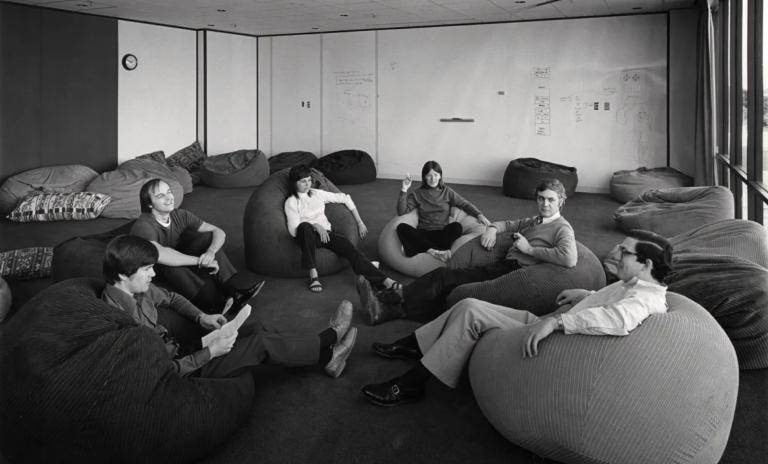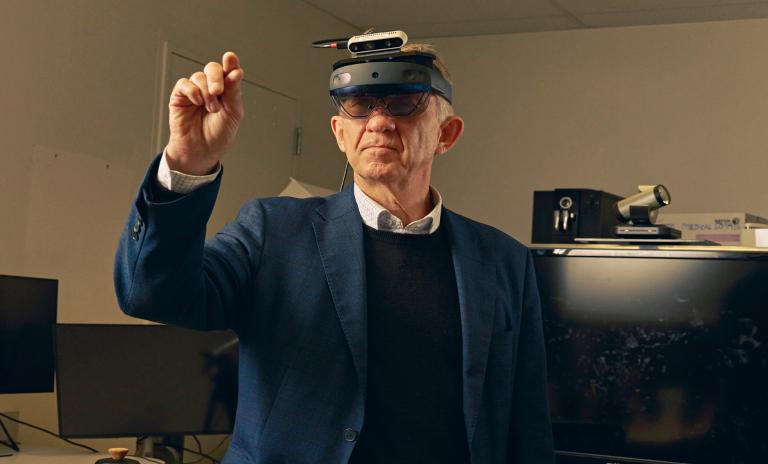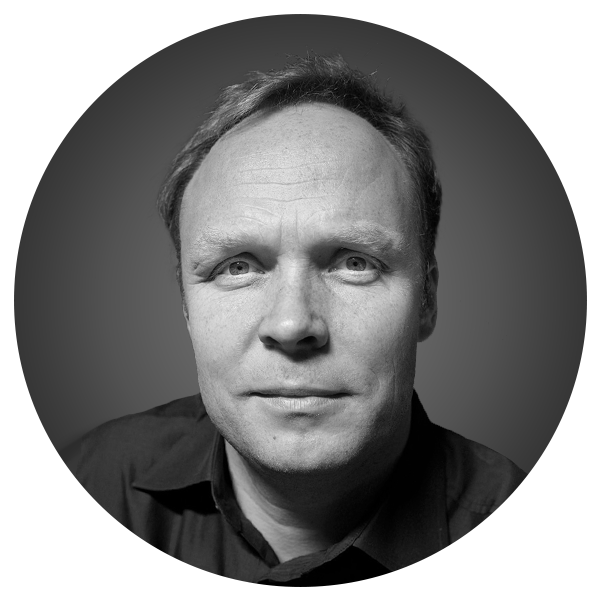The new blueprint for innovation
![{[downloads[language].preview]}](https://www.rolandberger.com/publications/publication_image/ta45_en_cover_download_preview.jpg)
The latest edition of Think:Act prepares us for innovation in 2025 and beyond while faced with constrained resources and uncertainty across the business landscape.
_background_none.png?v=1372397)

by Steffan Heuer
Photos by Balazs Gardi
Skunkworks were de rigueur during the golden age of the modern corporation, giving researchers the freedom to hatch groundbreaking ideas in secrecy. Yet times have changed. Today's focus on cost and constant innovation may require a new approach.
Once upon a time, in 1970, a magical place quietly opened for business in Palo Alto. Its founder, the nuclear physicist George Pake, had arrived in Northern California with a mandate from the Xerox Corp. in Rochester, New York, to invent "the office of the future." This new R&D lab called Palo Alto Research Center (or PARC) was to be undisturbed and largely unrestrained by the bureaucracy governing headquarters clear across the country. Pake hired a few dozen young and hungry researchers and warned the CEO back east to not expect anything tangible in the next five years. "He told his bosses that if we haven't produced anything usable in 10 years, then you can start asking questions. But for the first five, let us follow our noses and go where we want to go." That is how Los Angeles Times business columnist Michael Hiltzik and author of Dealers of Lightning, considered the ultimate history of PARC, sums up the center's grandiose goose chase to invent the future.

And invent they did. PARC was the one place where many of the fundamental pieces of today's networked world were dreamed up: the first laser printer; the first personal computer called Alto; the ethernet that laid the groundwork for the internet; the mouse; the graphical user interface or GUI; electronic paper; object-oriented programming. Yet apart from the laser printer, Xerox failed to grasp the potential of its other inventions and did not commercialize them, instead allowing its researchers and ideas to leave the building to become smashing successes elsewhere.
The most famous part of this saga of "invented, but not commercialized here" fell into the lap of Steve Jobs. He toured PARC in 1979, saw the Alto and tweaked the idea to become the iconic Lisa and Macintosh computers. Back in 1996, he said out loud what most innovation experts believe to this day: "They just grabbed defeat from the greatest victory in the computer industry. Xerox could have owned the entire computer industry." That assessment encapsulates the dilemma facing any corporation setting up semisecret or top secret development teams and giving them leeway to dream big. What's the right setup, scope of work and level of autonomy to make sure such skunkworks yield commercial dividends to the company – and not just the tech world or society at large? And do skunkworks even make sense in this day and age when continuous innovation seems to bubble up from thousands of startups and disruption is the norm, not the sought-after exception?
The term "skunkworks" has a funny origin. A team working for aerospace manufacturer Lockheed Martin adopted the moniker from the classic comic strip Li'l Abner which made frequent references to a secret place in the woods where "skonk oil" was brewed from a mix of skunks, old shoes and other ingredients. Because of the horrid smell, people avoided the place and those who worked there – which seemed like a good inside joke to the secret team working on airplanes next to a plastics factory outside LA. In due time, they even developed a skunk logo for their special R&D operation, which started out hidden in a hangar at Burbank Airport north of Los Angeles where a team of engineers successfully and quickly churned out novel aircraft designs.
Secret no more, the famous Lockheed outfit exists to this day, and the company has even trademarked the term and proudly posted the founder's "14 rules and practices for project work" on a website. Leaving the military requirements aside, they list giving complete control of the program to its manager, using "a small number of good people," keeping paperwork requirements to a minimum, providing timely funding to get the job done and strictly limiting outside access.

While the definition of what separates a skunkworks from an R&D lab is fairly fluid, these core principles applied for decades as large corporations from IBM to 3M to Facebook parent Meta sought to refill their innovation pipeline, says long-time Silicon Valley forecaster Paul Saffo. "It's driven by employees who are passionate about something and doing it against all odds," he explains. "If it's too formalized and top-down, it's probably not a skunkworks. And it's definitely not one when you advertise or trademark it." Importantly, he doesn't see the immediate success of a specific product as a decisive factor, but hastens to add that shareholder activism has more or less killed such endeavors.
"If it's too formalized, it's probably not a skunkworks. And it's definitely not when you trademark it."
With a few notable exceptions. Take X, a loose collection of moonshot projects that search giant Google secretly launched in January 2010 under the leadership of co-founder Sebastian Thrun. The Stanford computer scientist had made a name for himself in the fields of artificial intelligence and autonomous driving when Google's co-founders Larry Page and Sergey Brin tapped him for a 21st-century skunkworks. "They looked at two different use cases: innovating within an existing branch of business and innovation that's disruptive and discontinuous. Something new, like self-driving cars," Thrun recalls. "We felt we needed a separate institution that can incubate those projects and turn them into real businesses."
German-born Thrun, now 57, did exactly that. First came a half-year-long deep dive into technology and business opportunities, he says, driven by basic questions: "How can we make meaningful progress in a field? Is the technology reasonably ready and the timing right?" About half of all ideas were considered "pipe dreams" and rejected. Those that made it over the initial hurdle were given "maximum operating freedom," as Thrun tells it. He kept teams as small as possible, only recruiting a leader for each project and telling them to hire three to four of the best graduate students they could find. The sales pitch was always the same: "Come to Silicon Valley and you can do the project of your dreams. You don't have to worry about fundraising or reporting. There's never a PowerPoint presentation."
This conceptual phase usually comprised three to five people, with the ensuing prototyping phase scaling up to 15 people. If there was a go-to-market phase, Thrun adds, the headcount would increase significantly. That's one reason why Google X employed 500-600 people at its peak, he estimates. Juggling so many balls simultaneously also meant he would run no more than six projects at a time, devoting roughly one day a week to each.
Location matters, too, because it's crucial to be "as close as humanly possible" to the leaders footing the bill for a skunkworks, according to Thrun. "If you have a CEO who really cares about innovation and advancing technology, you want to be able to connect many, many times and get that person's guidance, wisdom and enthusiasm." In his case, that meant working in an innocuous building right next to Google headquarters in Mountain View whose purpose wasn't known to the outside world until late 2011, when The New York Times broke the story. Thrun also managed to keep fellow employees out: "I wanted to keep the team secret inside Google so we wouldn't be flooded with internal tourists who'd want to help."
Dedication alone doesn't suffice, however. While one of the lab's initial ideas, self-driving cars, has turned into Waymo and become a booming business for Google parent Alphabet, most of the other moonshots didn't fare that well. That's particularly true for those further removed from the core business, such as energy-generating kites or converting seawater into carbon-neutral fuel. Even tech products didn't always pan out. Google Glass, for instance, crashed spectacularly after a widespread public backlash and "wasn't ready," Thrun admits today. [You can read more about the philosophy behind X's projects in our interview with X co-founder Astro Teller.] But for Thrun there was one major lesson from his time at X: "From the get-go, you should try to really understand the business environments and dynamics in which people make a purchasing decision."
A lack of focus on commercialization and churning out new products is the fatal flaw in all such ambitious R&D ventures, say critics. "Skunkworks need to die," contends entrepreneurship author Steve Blank, who derides the mysterious labs as "innovation theater" to grab headlines and juice the stock price. "By the middle of this century, the only companies with skunkworks will be the ones that have failed to master continuous innovation."
The new way to innovate at the bleeding edge, he argues, is to create an ambidextrous organization. One that exploits today's markets while exploring ideas everywhere – and has a mechanism in place to spread them throughout the organization. Blank's prime example is aerospace company SpaceX. It has two parts, he explains: a launch business that must be fail-safe and get payloads into orbit aboard a Falcon 9 rocket several times a week. And a wild and crazy side that is expected to blow up and crash-land rockets for a living, what Blank calls the "safe to fail" business. "If you're not blowing things up, you're not innovating. And if you're not blowing them up on a regular basis, you're not innovating fast enough," he says.
What makes this setup work, according to the author of several books on lean startups, is the fact that both parts of the company do not work in siloes. "The Falcon 9 rocket folks understand the future is Starship, that experimentation will eventually become mainstream. In the past, you would have called Starship a skunkworks, but to me, it's a great example of a company with a complex organization and instant, institutionalized ambidexterity. It's like running a VC portfolio inside your company."
Indian-born tech entrepreneur and academic Vivek Wadhwa goes one step further and dismisses any corporate R&D or innovation center as wasteful window dressing. "Those are the most incompetent, ineffective parts of the company because the people there get rewarded for filing patents and working on useless things instead of commercializing actual products," he scoffs. "They are cut off from the realities of the world."
Instead, Wadhwa favors suffusing the entire company with the skunkworks spirit. "I advise big companies all the time to take different people from different parts of the organization – marketing, developers, even finance – and stick them together in small teams. Launch hundreds of micro-skunkworks, put limited budgets on them and see what comes of it." Small is beautiful, Wadhwa adds: "I've never seen an R&D team that's larger than seven people and actually effective."

Connecting many initiatives with each other, insulating them from the general bureaucracy while closely liaising with the leadership is a delicate balance, concurs Saffo: "Companies need to create something like a republic of skunkworks inside their walls. It's like nurturing a diverse community that has playpens for disruption." It also has the added benefit of engaging the brightest minds so they don't leave.
Skunkworks in many cases have been replaced or superseded by a range of exploratory approaches: scouting for startups and quickly investing in them through a corporate venture arm, or swallowing them outright for their talent and intellectual property. Some large players also establish joint ventures with academia to generate ideas. Chemical giant DuPont, for instance, in 2017 teamed up with the University of Delaware and the state government to open a Delaware Innovation Space housing early-stage startups. The price tag at launch was relatively small, totaling just $18.25 million, but seven years later, the new outfit lists a portfolio of around 90 companies. "Large companies have realized that the innovation capabilities of small entrepreneurs and small groups of people are greater than their own innovation capabilities," says Wadhwa. Big tech companies in particular acquire startups by the dozens. Google alone bought 222 companies between 2000 and 2024, Microsoft snapped up 140 and Apple acquired 102 young firms during the same time frame.
That's not to say corporations have completely given up on the idea – and halo – of a mysterious R&D outfit. Ford generated quite a few headlines when CEO Jim Farley revealed during an earnings call in early 2024 that the carmaker had established a skunkworks with a headcount of 300 people. The secret team's advantage, according to Farley: "They don't have the prejudices I would as an old-school car person." That's an ambitious claim, especially in light of the fact that Ford lost $5 billion on its electric vehicles in 2024 alone.
Perhaps staring at the monetization potential of one individual company's skunkworks is too myopic a metric. Any innovative outfit eventually contributes to technological progress and business success somewhere, says PARC chronicler Michael Hiltzik. "Xerox leadership had the foresight to let researchers loose. But they ultimately did not know what to make of their inventions and enter an entirely new business that no one at the time knew what it really was," Hiltzik says. That's why third parties such as Apple stepped in and quickly carried the torch forward.

![{[downloads[language].preview]}](https://www.rolandberger.com/publications/publication_image/ta45_en_cover_download_preview.jpg)
The latest edition of Think:Act prepares us for innovation in 2025 and beyond while faced with constrained resources and uncertainty across the business landscape.
